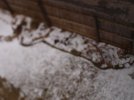Chicago's winter so far has been very mild, knock on wood. I may be able to start working on my outdoor enclosure sooner than I thought. I need some suggestions. I have an area of my koi pond that I am taking up and giving to my leopard. I need suggestions on what to do with it. Fill it in, if so, with what, dirt, stones, natures wood(sticks and stuff) plants etc. or should I leave it a hole and again put what in it? In the picture it is the left side upper part of pic. Sorry for the blurry pic. You should still be able to see what I am talking about. You just can't see how ugly my yard looks in winter. The rest of the enclosure has grass, weeds, 2-palm trees, 1-japanese red maple tree, twisted cherry tree and some edible flowers and hosta.
All recommendations appreciated. Sorry for the long post.
Thank you
P.S. Its there area that looks stoned in. Hope you can tell what I mean

All recommendations appreciated. Sorry for the long post.
Thank you
P.S. Its there area that looks stoned in. Hope you can tell what I mean

Last edited by a moderator: